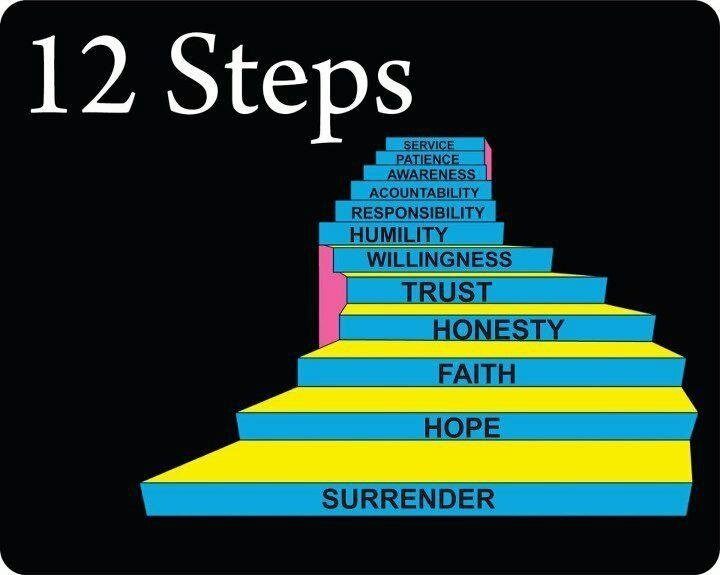Embarking on the path to sobriety is both courageous and transformative. For those struggling with alcohol addiction, the Twelve Steps of Alcoholics Anonymous steps (AA) offers a roadmap to recovery, providing guidance, support, and a framework for personal growth. In this blog series, we’ll explore each step in depth, delving into its principles, practices, and the profound impact it can have on individuals seeking a life free from alcohol dependence.
Contents
What Are The Alcoholics Anonymous Steps?
 The Alcoholics Anonymous Steps are a set of guiding principles designed to help people struggling with alcohol addiction find a path to recovery. There are twelve steps in total, each focusing on different aspects of self-awareness, acceptance, and spiritual growth. These steps encourage individuals to admit they have a problem with alcohol. And, continue to grow and support others in their journey to sobriety.
The Alcoholics Anonymous Steps are a set of guiding principles designed to help people struggling with alcohol addiction find a path to recovery. There are twelve steps in total, each focusing on different aspects of self-awareness, acceptance, and spiritual growth. These steps encourage individuals to admit they have a problem with alcohol. And, continue to grow and support others in their journey to sobriety.
In simpler terms, the Alcoholics Anonymous Steps are like a roadmap for people who want to stop drinking and find a healthier way to live. They help individuals recognize their problems, find support from others who understand, and take positive steps toward changing their behavior. By working through these steps, many people have found hope, healing, and a new sense of purpose in their lives.
What Are The Examples Of Alcoholics Anonymous Steps?
Embarking on the path to recovery from alcohol addiction can be daunting, but within the Twelve Steps of Alcoholics Anonymous lies a profound roadmap to freedom and transformation. Each step offers a beacon of hope, guiding individuals through a journey of self-discovery, healing, and spiritual growth. Let’s explore these steps below.
12 steps
Certainly! Here’s a simplified breakdown of the Alcoholics Anonymous steps:
Admitting Powerlessness
This step involves recognizing that alcohol has become unmanageable in your life, and acknowledging that attempts to control or stop drinking on your own have been unsuccessful. It’s about accepting that alcoholism is a disease that you cannot overcome through sheer willpower alone.
Believing in a Higher Power
Here, the focus is on finding faith in a power greater than yourself. This can be a traditional deity, a spiritual force, or even the collective strength of the AA group. The key is to believe that this higher power can offer guidance, support, and healing on your journey to recovery.
Surrendering to the Higher Power
 Once you acknowledge the existence of a higher power, this step involves relinquishing control and trusting in its ability to help you overcome alcohol addiction. It’s about letting go of ego and self-will and being open to receiving help and guidance from something beyond yourself.
Once you acknowledge the existence of a higher power, this step involves relinquishing control and trusting in its ability to help you overcome alcohol addiction. It’s about letting go of ego and self-will and being open to receiving help and guidance from something beyond yourself.
Taking a Moral Inventory
This step requires a thorough and honest self-assessment. It involves examining your past actions, behaviors, and attitudes related to alcohol use, as well as identifying underlying emotions and motivations. By taking stock of your past, you can gain insight into patterns of behavior and areas for personal growth.
Admitting Wrongs
After completing your moral inventory, this step involves sharing your findings with yourself, your higher power, and another trusted individual, often a sponsor or fellow AA member. It’s about acknowledging the harm you’ve caused through your alcohol use and taking responsibility for your actions.
Being Ready for Change
Building on the insights gained from your moral inventory, this step is about developing a genuine willingness to let go of destructive patterns and character defects associated with alcohol addiction. It requires openness to change and a commitment to personal growth.
Asking for Help
In this step, you humbly ask your higher power to remove your shortcomings and help you become the person you aspire to be. It’s about surrendering your flaws and weaknesses, trusting that your higher power can guide you towards a better way of living.
Making Amends
This step involves making a list of people you have harmed as a result of your alcohol use and being willing to make direct amends to them. It’s about taking concrete actions to repair relationships and address the consequences of your past behavior.
Making Direct Amends
Building on the previous step, here you reach out to those you have harmed, apologize sincerely, and make restitution for any harm caused. This may involve admitting wrongdoing, making financial restitution, or offering support and assistance where possible.
Continuing Personal Inventory
This step emphasizes the importance of ongoing self-reflection and accountability. It involves regularly examining your thoughts, actions, and behaviors, and promptly admitting when you are wrong. By staying vigilant and honest with yourself, you can address issues as they arise and avoid falling back into old patterns.
Seeking Spiritual Growth
Here, the focus shifts to deepening your spiritual connection with your higher power. This may involve prayer, meditation, attending religious services, or engaging in other spiritual practices that help nurture your relationship with something greater than yourself.
Helping Others
The final step is about giving back and sharing the gifts of recovery with others. It involves sharing your experience, strength, and hope with those who are still struggling with alcohol addiction, and offering support and guidance to help them on their journey to sobriety. By helping others, you reinforce your commitment to recovery and contribute to the ongoing healing and growth of the AA community.
Each of these steps is integral to the process of recovery from alcohol addiction. Thus, providing a framework for personal growth, spiritual development, and lasting sobriety. Working through the Twelve Steps with the support of a sponsor and fellow AA members can be a transformative journey towards a healthier, more fulfilling life.
What Are The Benefits You Can Expect?
Embarking on the journey of the Alcoholics Anonymous steps can yield a multitude of benefits for individuals committed to recovery:
1. Sobriety
One of the primary benefits is achieving and maintaining sobriety. By following the Twelve Steps, individuals learn coping mechanisms and develop tools to resist the urge to drink. Hence, leading to a life free from the destructive cycle of addiction.
2. Personal Growth
The Twelve Steps provide a framework for profound self-exploration and growth. Through honest self-assessment, individuals confront their past behaviors and beliefs, paving the way for personal transformation and improved self-awareness.
3. Emotional Healing
Addressing past traumas, resentments, and guilt through the Twelve Steps can lead to emotional healing and greater psychological well-being. By making amends and seeking forgiveness, individuals can experience relief from the burden of unresolved emotions.
4. Improved Relationships
Working through the Twelve Steps often involves repairing damaged relationships and fostering healthier connections with others. By taking responsibility for past mistakes and actively seeking to make amends, individuals can rebuild trust and strengthen their bonds with loved ones.
5. Support Network
Participating in Alcoholics Anonymous meetings and working with a sponsor provides a built-in support network of individuals. They can understand the challenges of addiction firsthand. This sense of community and fellowship can offer encouragement, accountability, and companionship on the journey to recovery.
6. Spiritual Connection
For many, the Twelve Steps offer a path to spiritual awakening and a deeper connection with a higher power. By surrendering control and seeking guidance from something greater than themselves, individuals can find solace, purpose, and meaning in their recovery journey.
7. Continued Growth and Maintenance
Recovery is an ongoing process, and the Twelve Steps provide a lifelong framework for continued growth and maintenance. By practicing the principles of the Twelve Steps in all areas of life, individuals can sustain their sobriety and thrive in their journey of recovery.
While the benefits of working through the Twelve Steps may vary for each individual, the overarching goal is to achieve lasting sobriety. Also, emotional well-being, and a renewed sense of purpose and fulfillment in life.
Do The 12 Steps of AA Have To Be Done In Order?
 While it’s generally recommended to work through the Twelve Steps of Alcoholics Anonymous in order, it’s not strictly required. The sequence of the steps is designed to build upon each other, with each step laying the foundation for the next. However, some individuals may find that certain steps resonate more strongly with them. And, that they need to revisit certain steps multiple times in their recovery journey.
While it’s generally recommended to work through the Twelve Steps of Alcoholics Anonymous in order, it’s not strictly required. The sequence of the steps is designed to build upon each other, with each step laying the foundation for the next. However, some individuals may find that certain steps resonate more strongly with them. And, that they need to revisit certain steps multiple times in their recovery journey.
Flexibility in the order of the steps can be particularly beneficial for individuals. Because they may struggle with certain steps initially or who have unique circumstances that require a different approach. For example, someone may find it helpful to begin with Step 4 (Taking a Moral Inventory) before fully embracing Step 2 (Believing in a Higher Power).
Ultimately, the goal of the Twelve Steps is to facilitate personal growth, healing, and sobriety. As long as individuals are actively engaged in the process, they can adapt the sequence to best suit their needs and circumstances.
Conclusion
In conclusion, Alcoholics Anonymous steps offer a transformative journey towards sobriety, self-discovery, and spiritual growth. By following these steps with dedication and openness, individuals can break free from the grip of alcohol addiction. While the path to recovery may be challenging at times, the support of fellow AA members, the guidance of a sponsor, and a willingness to embrace change can provide the strength.
Ultimately, the Steps serve as a beacon of hope for those seeking a brighter future. And also, offering a roadmap to lasting sobriety and a renewed sense of hope, happiness, and fulfillment in life.
